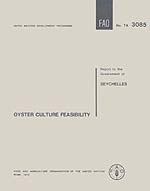
to the
GOVERNMENT OF SEYCHELLES
on
OYSTER CULTURE FEASIBILITY
| UNITED NATIONS DEVELOPMENT PROGRAMME SEY/71/1 | No. TA 3085 |
 | R E P O R T to the GOVERNMENT OF SEYCHELLES on OYSTER CULTURE FEASIBILITY |
Based on the work of
K.W. Cox
Fishery Officer (Fishing Technologist and Industry Expert) and Project Manager
FAO/UNITED NATIONS DEVELOPMENT PROGRAMME (TECHNICAL ASSISTANCE) REPORTS ON FISHERIES
This document is Report No. TA 3085 in the series of FAO reports produced under the United Nations Development Programme (UNDP). Since 1 January 1966, reports produced under the former Expanded Programme of Technical Assistance (EPTA) have appeared in the UNDP(TA) series. The numbering of reports in the UNDP(TA) series is unbroken and follows consecutively the numbering of the former EPTA series.
Since 1 January 1962, those reports which concerned FAO Technical Assistance in fisheries have been numbered consecutively in a subseries within the general series.
The present report is the two hundred and twenty second report in the fisheries subseries: FAO Fish.UNDP(TA) Rep., UNDP(TA)222
For bibliographic purposes this document may be cited as follows:
FAO 1972 Report to the Government of Seychelles on the results of the Oyster Culture Feasibility Survey. Based on the work of K.W. Cox, Fishery Officer (Fishing Technologist and Industry Expert) and Project Manager. Rep.FAO/UNDP(TA). (3085) : (i) 22 p.
The designations employed and the presentation of the material in this document do not imply the expression of any opinion whatsoever on the part of the United Nations or the Food and Agriculture Organization of the United Nations concerning the legal or constitutional status of any country, territory or sea area, or concerning the delimitation of frontiers.
FAO. Report to the Government of the Seychelles on the Results of the Oyster Culture Feasibility Survey, based on the work of K.W. Cox, Rome, 1972. 22 p. United Nations Development Programme, Report No. TA 3085 ABSTRACT The report gives an account of a survey in the Seychelles to determine the feasibility of large scale oyster culture and gives recommendations for an experimental pilot project based on the results of the findings. It is designed to determine the most efficient methods and techniques for rearing oysters under local conditions in amounts sufficient to meet the anticipated demands. Among the recommendations based on the survey are (1) to apply the most recent techniques and methods for production on a large scale of oyster culture on a commercial basis in several areas in Mahé, following certain basic conditions (2) that an oyster culture pilot project be established at Anse à la Mouche to determine the best and most efficient methods for producing oysters in amounts sufficient to meet future anticipated market demands (3) that a qualified shellfish expert be engaged to direct and supervise the project in collaboration with a government fisheries officer, four semi-skilled labourers and one fisherman/boatman. Two methods are given for obtaining young seed oysters with a suggested plan of operation and a proposed time schedule. |
FOOD AND AGRICULTURE ORGANIZATION OF THE UNITED NATIONS
Rome, 1972
Hyperlinks to non-FAO Internet sites do not imply any official endorsement of or responsibility for the opinions, ideas, data or products presented at these locations, or guarantee the validity of the information provided. The sole purpose of links to non-FAO sites is to indicate further information available on related topics.
This electronic document has been scanned using optical character recognition (OCR) software. FAO declines all responsibility for any discrepancies that may exist between the present document and its original printed version.
1.1 Background Information
1.2 Development of the Project
1.3 Acknowledgements
CHAPTER 3 CONCLUSIONS AND RECOMMENDATIONS BASED ON THE SURVEY
1. Plans of Operation and Time Schedules
Illustrations
1. Areas of Native Oysters (Crassostrea cucullata)
2. Raft Culture
3. Five Rafts
4. The Longline Method
5. Japanese Methods of Rack Culture
6. Oyster Culture Tray with Wooden Frame
7. Specifications for Trays
2. Estimate of Costs - Equipment/Materials
3. Costs of Imported Seed Oysters
4. Preliminary Cost Analysis
5. Trays - Specifications